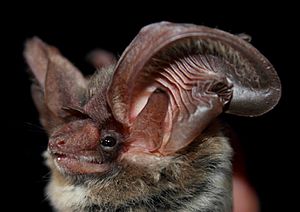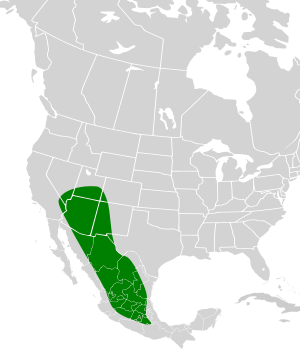Allen's big-eared bat facts for kids
Quick facts for kids Allen's big-eared bat |
|
|---|---|
 |
|
| Conservation status | |
| Scientific classification | |
| Genus: |
Idionycteris
|
| Species: |
phyllotis
|
 |
|
The Allen's big-eared bat (Idionycteris phyllotis) is a special type of bat known for its really big ears! It's part of a group called vesper bats. This bat is the only species in its unique group, called Idionycteris. You can find these bats living in Mexico and in several states across the United States, including Arizona, California, Nevada, New Mexico, Utah, and Colorado.
Contents
About Allen's Big-Eared Bat
What Does It Look Like?
The Allen's big-eared bat has very large ears, as its name suggests. These bats are quite light, usually weighing between 8 to 16 grams. That's about as much as two teaspoons of sugar!
On their back, which is called the dorsal side, they have long, soft fur. This fur is dark, almost black, at the bottom near their skin. But the tips of their fur are a yellowish-gray color.
You might also notice a black patch of fur on each of their shoulders. They have a small tuft of white hair right behind their ears. Their belly side, known as the ventral side, has hairs that are black with lighter tips.
Special Body Parts
Bats have some unique body parts. The Allen's big-eared bat has a small bony part on its ankle called a calcar. This calcar has a small ridge, like a tiny keel.
Their tail membrane, called the uropatagium, has about 12 to 13 small ridges across it. Their nose area, or rostrum, is flat and wide.
How They Hunt
The way Idionycteris phyllotis is built, or its external morphology, is similar to bats that glean. This means they are good at picking up insects that are sitting still on surfaces, like leaves or tree trunks.
To do this, they have long ear flaps called tragi and large ears. Their wings are also designed to help them fly slowly and hover in one spot. Their jaw is light and slender, which is called gracile.
The Allen's big-eared bat is the only bat in North America known to make special, long echolocation calls. These calls use a mix of constant frequency and frequency-modulated sounds. This helps them find insects in the dark.
Where They Live
Their Home Range
The Allen’s big-eared bat lives in the mountains of the southwestern parts of Mexico and the United States. They can be found in many different places, from lower areas to very high up in the mountains.
Altitude and Habitat
These bats live at a wide range of heights, from about 855 meters (about 2,800 feet) up to 3,225 meters (about 10,580 feet) above sea level. However, most of these bats prefer to live at heights between 1,100 meters (about 3,600 feet) and 2,500 meters (about 8,200 feet).
See also
 In Spanish: Idionycteris phyllotis para niños
In Spanish: Idionycteris phyllotis para niños


